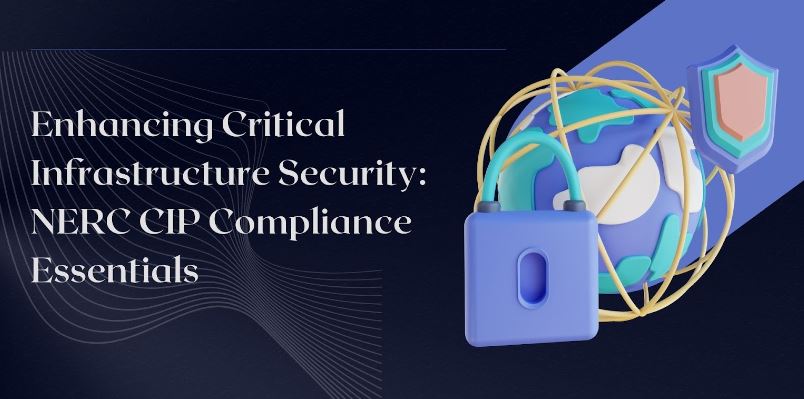Keeping the lights on is so important for all of us. But being more plugged in has made the power grid vulnerable to cyber crooks. To lower the risk, the North American Electric Reliability Corporation created new cybersecurity rules called NERC CIP. These guidelines help protect the digital systems that run the electric grid.
Adhering to the NERC CIP guidelines enhances security. The rules require common sense things like finding where risks are high, using layered protection, controlling access, and planning for incidents. Implementing reasonable safeguards enables power companies to prevent attacks and prevent blackouts.
This article outlines the key parts of NERC CIP compliance. It also suggests effective methods for implementing the standards. This helps strengthen cybersecurity for critical systems. The infrastructure we all count on is now more exposed. Properly following the NERC CIP rules helps keep modern society’s vital systems safe.
- Overview of NERC CIP Standards
- Cybersecurity Objectives of NERC CIP Standards
- How NERC CIP Standards Are Developed
- Relationship Between CIP Standards and Other BES Reliability Standards
- BES Cyber System Identification and Strategies for Lowering Their Impact Rating
- Nuances of NERC Defined Terms and CIP Standards Applicability
- Significance of Properly Determining Cyber System Impact Ratings
- Strategic Implementation Approaches for Supporting Technologies
- Effective Implementations for Cyber and Physical Access Controls
- Conclusion
- FAQs
Overview of NERC CIP Standards
The NERC CIP standards are cybersecurity rules. Their goal is to protect the bulk power system from cyber threats. These threats could hurt reliability and security. The NERC CIP standards apply to certain owners, operators, and users. They apply to those with high and medium cyber risk assets.
The aim is to reduce cyber risks, thus safeguarding the technology supporting the critical bulk electric system (BES). A 2020 NERC report had insights. More entities followed the NERC CIP standards from 2018 to 2019. The number grew 5.4% to 1,612 entities.
This growth shows the importance of the NERC CIP standards. It shows they help protect critical infrastructure cybersecurity. Mandatory NERC CIP compliance matters. It encourages owners and operators to keep improving cyber protections.
In summary, the focus on NERC CIP compliance is now more critical than ever due to the continuous evolution of cyber threats. Proper NERC CIP implementation secures vital digital grid systems. This infrastructure is essential to daily life.
Proper implementation of the NERC CIP cybersecurity standards is crucial for critical infrastructure owners and operators. However, balancing reliability and security objectives with regulatory compliance can prove challenging.
The number of annual NERC CIP noncompliance submissions highlights improving compliance across the industry. Look at the following data from the Compliance Monitoring and Enforcement Program and Organization Registration and Certification Program Annual Report by NERC.
The decreasing noncompliance trends reflect strengthened implementation and accountability. Power companies are getting better at following the NERC CIP rules. Finding and fixing gaps is key to improving security.
New cyber threats are always popping up. So power companies need to keep learning, checking, and upgrading. Focus on real security, not just on compliance. That will make the grid most resilient. There’s still progress to be made.
But fewer violations over time is real progress. It shows critical systems are more locked down now. Staying alert and getting even better at NERC CIP boosts cybersecurity. This protects the infrastructure we all need. The power companies just have to keep at it. Use common sense to keep the lights on and hackers out./
Cybersecurity Objectives of NERC CIP Standards
At its core, the NERC CIP standards try to give us a solid cybersecurity framework. This helps reduce weaknesses and better protect the digital systems running the bulk electric grid.
What does this mean? Well, think of it like building a secure home.
-
First, identifying the most critical systems for maintaining power is essential. These crucial assets need advanced protections, like a home security system for your master bedroom.
-
Second, develop good access controls like passwords, encryption, and firewalls. It’s like locking doors and windows and using alarm codes.
-
Third, implement security management controls. This is like having a response plan in case of a break-in, or changing locks when someone moves out.
-
Fourth, provide education on cyber risks and best practices to all personnel. Teach your family how to stay safe, just like personnel training for grid threats.
-
Finally, have plans to restore affected systems after an attack. It’s like keeping spare keys with a neighbor in case you get locked out.
-
By providing flexible standards rather than hyper-specific rules, NERC CIP lets utilities secure assets based on their unique risks. Sort of like how each homeowner chooses protections to fit their neighborhood.
The bottom line – NERC CIP gives us a tested framework so we can better guard the critical systems we all rely on. Just like securing your home, it takes work but gives peace of mind.
How NERC CIP Standards Are Developed
The Federal Energy Regulatory Commission (FERC) oversees NERC CIP standards. FERC reviews proposed standards. This ensures they protect critical grid cyber assets properly.
NERC follows a thorough process to make new or updated CIP standards:
-
Industry volunteers draft initial CIP revisions.
-
Proposed standards go through a 45-day public comment period. This allows stakeholder input.
-
The team reviews feedback and modifies the standard as needed.
-
Industry groups vote to approve the final draft standard.
-
The NERC Board reviews the votes and adopts approved standards.
-
NERC asks FERC to mandate the standards.
This process enables wide engagement. It ensures standards address the latest threats. It also allows flexibility for different industry segments.
CIP standards get regular updates as technology and threats change. This practice ensures the standards remain relevant, with noncompliance penalties being mandatory. They encourage strengthening protections continuously.
Relationship Between CIP Standards and Other BES Reliability Standards
Although primarily focused on cybersecurity, the NERC CIP standards are integral components of a broader set of standards aimed at guaranteeing the reliability and security of the BPS. Some of the other key NERC reliability standards categories include:
-
Protection and control systems
-
Personnel training and qualifications
-
Facilities design, connections, and maintenance
-
Emergency preparedness and operations
-
Interconnection reliability
Collectively, these standards establish the fundamental requirements for managing reliability risks within the BPS. As cybersecurity threats increase, the CIP standards are becoming ever more crucial for critical infrastructure protection.
BES Cyber System Identification and Strategies for Lowering Their Impact Rating
To follow the CIP rules, power companies first need to identify their important cyber systems. They must check their systems against the criteria in CIP-002. This determines if systems are High, Medium, or Low impact. Higher-impact systems need more CIP protections. Identifying the critical cyber systems right is key. It lets power companies know which systems need the strongest defenses.
Strategies for minimizing the CIP impact level of cyber assets include:
-
Careful scoping of BES Cyber System Boundaries
-
Reducing connectivity and access points between systems
-
Limiting external routable protocol paths
-
Removing unnecessary software applications
-
Planning for shorter data retention periods
Through these impact reduction methods, entities can potentially avoid the significant resource expenditures involved with complying with CIP requirements for high or medium-impact BES Cyber Systems.
Nuances of NERC Defined Terms and CIP Standards Applicability
To apply the NERC CIP standards right, you have to understand the specifics. Little differences between terms like “BES Cyber Asset” and “Protected Cyber Assets” matter.
Subtle wording affects what systems need CIP protections. It’s like reading the fine print on contracts. The details make a difference. You have to review the standards closely for exceptions and caveats too.
This helps figure out what systems can have lower CIP requirements. Carefully evaluating all these specifics helps focus CIP compliance only where essential. Misreading the terminology can lead to wasting money securing non-critical systems.
In total, success means studying the NERC CIP language closely. Mastering the nuances ensures protections match real risks. It’s just like reading instructions carefully before assembling furniture. Concentrating on the details saves time and frustration.
Significance of Properly Determining Cyber System Impact Ratings
Correctly evaluating and designating the impact level of each BES Cyber System is crucial for ensuring cost-effective CIP compliance. Higher impact systems require significant additional protections like:
-
Dual-factor authentication for all interactive access
-
Daily cyber vulnerability assessments
-
Strict change management controls
-
Physical security protections such as fenced perimeters and 24/7 personnel monitoring
Power companies need to rate their systems correctly. Rating a system too high when it doesn’t meet the criteria leads to wasted money on security. Rating a critical system too low leaves the grid open to risk.
Get the impact rating right. If the criteria say a system is medium or low impact, don’t overspend protecting it. But don’t underestimate systems that keep the grid running. Missing something important creates vulnerabilities.
Rate each system properly. Follow the criteria closely. That balances security and costs. It keeps the grid safe without overspending.
Strategic Implementation Approaches for Supporting Technologies
Efficiently implementing security tools and technologies is essential for achieving CIP compliance. Strategic approaches should include:
-
Planning implementations to align with business risk management objectives
-
Evaluating costs, benefits, and capability gaps of available technologies
-
Developing phased deployment plans coordinated across multiple sites
-
Allocating sufficient staff training time for new cybersecurity tools
Adhering to structured processes enhances the effectiveness of new cybersecurity tools. It helps improve CIP protections.
Effective Implementations for Cyber and Physical Access Controls
When power companies add new cybersecurity tools for CIP, following structured processes and best practices is key. Here is a comparison of effective implementation approaches for some common CIP-related technologies:
|
Technology |
Implementation Approach |
|
Firewall |
Align rules to security policies, test extensively, train staff on changes |
|
SIEM |
Tune alerts and dashboards for critical assets, validate log sources |
|
Vulnerability Scanning |
Schedule scans, integrate results into change controls and patching |
|
Encryption |
Determine use cases and requirements first, pilot with non-critical data |
Following structured deployment processes tailored to each technology’s capabilities enables entities to maximize the value of CIP-related cybersecurity investments.
Conclusion
Following the NERC CIP standards is still vital. It helps critical infrastructure owners address growing cyber threats. A balanced focus on compliance and real security is important. Understanding NERC requirements matters.
So does strategically using access controls and technologies. This lets entities target resources for maximum benefits. It improves reliability and protection.
Robust NERC CIP compliance capabilities are imperative. They help secure our critical electric grid against new cyberattacks.
As threats rise, we must keep strengthening NERC CIP capabilities. The security of our critical systems relies on continuous and vigilant safeguarding. Will you help enhance our cybersecurity defenses?
FAQs
1. What are the 10 Fundamentals of NERC CIP Compliance?
The ten main parts of NERC CIP compliance are:
-
Controlling access to ports and services
-
Managing security patches
-
Preventing malicious code
-
Monitoring security events
-
Controlling access to systems
-
Training personnel
-
Using electronic security perimeters
-
Physical security
-
Incident response planning
-
Managing configuration changes
2. Why is it important to determine Cyber System impact ratings correctly?
It matters because higher ratings necessitate additional CIP protections, which can be costlier. Minimizing high ratings avoids unnecessary costs.
3. What are strategic ways to implement supporting technologies?
Strategic approaches encompass:
-
Aligning with business risk goals
-
Evaluating capability gaps
-
Phased rollouts across sites
-
Training on new technologies
This improves the value of CIP security investments.



